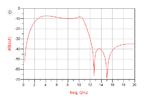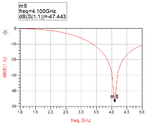Ata_sa16
Full Member level 6
- Joined
- Mar 29, 2016
- Messages
- 343
- Helped
- 59
- Reputation
- 118
- Reaction score
- 58
- Trophy points
- 28
- Location
- Milky Way Galaxy, 179° 56′ 39.4″
- Activity points
- 2,221
Hi people,
I want to understand how I can calculate parameters for this band pass matching circuit.
If you have any source about matching circuits like this, can you send it to me please.
Matching is done in frequency band of 3-5 GHz and the input network belongs to input equivalent resonant circuit of LNA.
my questions are:
1) why this topology is used, generally Pi or T circuits are used for band-pass matching.
2) How can I calculate this circuit parameters.
For example should I find the input Zin and try to match it to 50 ohm is 4 GHz !??!!?
I want to understand how I can calculate parameters for this band pass matching circuit.
If you have any source about matching circuits like this, can you send it to me please.
Matching is done in frequency band of 3-5 GHz and the input network belongs to input equivalent resonant circuit of LNA.
my questions are:
1) why this topology is used, generally Pi or T circuits are used for band-pass matching.
2) How can I calculate this circuit parameters.
For example should I find the input Zin and try to match it to 50 ohm is 4 GHz !??!!?


